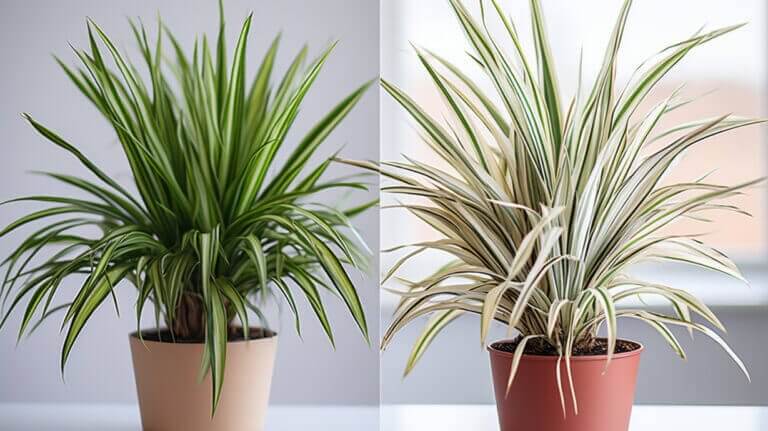Crown of Thorns (Euphorbia milii) is a beautiful succulent plant that can add a profusion of lovely flowers to your garden. If you want to enjoy its colorful blooms year-round, it’s important to provide the right care and growing conditions. Here are some tips to help you get your Crown of Thorns to bloom in all its glory.
Key Takeaways:
- Provide bright, indirect sunlight and well-draining soil for optimal flower production.
- Water sparingly, allowing the soil to dry out between waterings.
- Fertilize regularly with a balanced fertilizer to provide necessary nutrients.
- Prune the plant to encourage branching and new growth.
- Acclimate the plant gradually to changes in light and temperature.
Understanding Crown of Thorns: Plant Characteristics and Varieties
Crown of Thorns (Euphorbia milii) is a mesmerizing succulent plant that belongs to the spurge family. It possesses unique characteristics that make it a standout in any garden. With its sharp thorns and striking sword-like leaves, the Crown of Thorns adds a touch of intrigue to any space.
What truly sets this plant apart, however, are its gorgeous flowers. The Crown of Thorns produces clusters of pink, red, or yellow flowers that are actually modified leaves called bracts. These vibrant blooms create a stunning visual display and add a pop of color to any garden or indoor space.
There are numerous varieties of Crown of Thorns, each with its own distinct characteristics. From different flower colors to varying growth habits, there is a wide range of options to choose from. Whether you prefer the classic red flowers or the subtlety of pink or yellow, there is a Crown of Thorns variety to suit every gardener’s taste.
| Variety | Flower Color | Height (inches) |
|---|---|---|
| Ruby Glow | Red | 8-12 |
| Pink Beauty | Pink | 6-10 |
| Sunshine Yellow | Yellow | 10-14 |
As illustrated in the table above, each variety of Crown of Thorns possesses its own unique charm, allowing you to create a diverse and visually stunning garden. From the fiery red blooms of the Ruby Glow to the delicate pink petals of the Pink Beauty, these varieties offer endless possibilities for plant enthusiasts.
“The Crown of Thorns is a versatile plant that can thrive both indoors and outdoors. Its minimal care requirements and long-lasting blooms make it a popular choice for gardeners of all levels of experience.” – Gardening Expert
Growing Crown of Thorns: Tips for Success
When it comes to growing Crown of Thorns, there are a few key factors to keep in mind. Firstly, this plant thrives in bright, indirect sunlight, making it perfect for a sunny spot in your garden or a well-lit indoor space. Additionally, Crown of Thorns requires well-draining soil to prevent root rot and maintain its overall health.
Watering the plant sparingly is crucial, as Crown of Thorns is drought-tolerant and can withstand dry conditions. Allow the soil to dry out between waterings to prevent overwatering and promote healthy root development. Fertilizing regularly with a balanced fertilizer will provide the necessary nutrients for optimal growth and flowering.
Lastly, acclimate your Crown of Thorns gradually to changes in light and temperature. Sudden shifts can shock the plant and affect its overall well-being. By following these tips, you can ensure that your Crown of Thorns thrives and produces an abundance of beautiful flowers.
Tips for Growing Crown of Thorns: Propagation, Pruning, and Care
Growing Crown of Thorns (Euphorbia milii) can be a rewarding experience with its stunning flowers and minimal care requirements. To successfully grow this plant, it’s important to understand how to propagate, prune, and care for it. Here are some helpful tips:
Propagation:
Propagating Crown of Thorns is relatively easy and can be done through stem cuttings. Start by selecting a healthy stem, about 4-6 inches in length, and make a clean cut using a sharp, sterile knife or pruning shears. Remove any leaves from the lower portion of the cutting, leaving only a few at the top. Dip the cut end of the stem into a rooting hormone to promote root development, then plant it in a well-draining potting mix. Place the cutting in a warm and bright location, and lightly water it to keep the soil slightly moist. With proper care and patience, your cutting should root within a few weeks.
Pruning:
Regular pruning is essential for maintaining a healthy and attractive Crown of Thorns plant. Prune the plant in early spring before new growth begins. Use clean and sharp pruning shears to remove any dead, damaged, or overcrowded branches. This will help improve air circulation, stimulate new growth, and prevent the plant from becoming leggy. Additionally, removing spent flowers can encourage the plant to produce more blooms. Just be cautious when handling the plant as its thorns can be sharp.
Care:
Proper care is crucial for the overall well-being of your Crown of Thorns plant. Here are some care tips to keep in mind:
- Light: Crown of Thorns thrives in bright, indirect sunlight. Place the plant near a window that receives plenty of light, but avoid direct sunlight as it can scorch the leaves.
- Watering: Water the plant sparingly, allowing the soil to dry out between waterings. Overwatering can lead to root rot, so it’s best to err on the side of underwatering.
- Fertilization: Feed your Crown of Thorns with a balanced fertilizer every 2-4 weeks during the growing season (spring and summer). This will provide the necessary nutrients for healthy growth and vibrant blooms.
- Temperature: Crown of Thorns prefers warm temperatures between 60-85°F (15-29°C). Protect the plant from cold drafts and avoid placing it near heating vents or air conditioning units.
- Repotting: If your Crown of Thorns outgrows its current pot, you may need to repot it into a slightly larger container. Choose a well-draining potting mix and handle the plant with care to avoid injuring yourself on its thorns.
By following these tips for propagation, pruning, and care, you can ensure your Crown of Thorns plant thrives and rewards you with its stunning flowers. Whether you’re a beginner or an experienced gardener, this versatile plant is sure to add beauty to your indoor or outdoor space.
| Propagation | Pruning | Care |
|---|---|---|
| Propagating through stem cuttings | Prune in early spring before new growth | Provide bright, indirect sunlight |
| Use rooting hormone for root development | Remove dead, damaged, or overcrowded branches | Water sparingly, allowing soil to dry out |
| Plant in well-draining potting mix | Remove spent flowers to encourage more blooms | Fertilize with balanced fertilizer every 2-4 weeks |
| Place in warm and bright location | Handle with care due to sharp thorns | Avoid temperature extremes and cold drafts |
Troubleshooting and Additional Tips for Growing Crown of Thorns
When growing Crown of Thorns, you may encounter some common problems that can hinder its growth and flowering. However, with the right knowledge and techniques, you can address these issues and ensure the continued health and beauty of your plant.
Yellowing Leaves and Lack of Flowering
If you notice that your Crown of Thorns has yellowing leaves or is not producing flowers as expected, there are a few factors to consider. First, check the light conditions. Insufficient light can result in poor flowering. Ensure that your plant is placed in a bright location with indirect sunlight.
Another possible cause is inadequate nutrition. For optimal growth and flowering, use a balanced fertilizer specifically formulated for succulents. This will provide the necessary nutrients that your Crown of Thorns requires.
Pest Infestations
Crown of Thorns is generally resistant to pests, but it can still fall victim to common invaders such as mealybugs and spider mites. If you notice signs of infestation, such as webbing or tiny insects on the plant, take immediate action. Apply an appropriate insecticide to eliminate the pests and prevent further damage.
Pruning and Branching Techniques
If you want to encourage branching in your Crown of Thorns, pruning is a helpful technique. By removing the tip of a stem, you can stimulate the growth of new branches. Additionally, there are techniques you can try to promote branching without pruning, such as manipulating the plant’s environment or using specialized hormones. Research these methods to find one that suits your preferences.
One popular method is to encourage branching by placing the stem cutting in water. This technique can help stimulate the growth of new roots and branches. Simply place the cut end of a stem in a container of water and wait for new growth to emerge.
By troubleshooting common issues and implementing the appropriate solutions, you can overcome challenges and help your Crown of Thorns thrive. Remember to provide the right growing conditions, address any pest infestations promptly, and use pruning and branching techniques to shape your plant. With these additional tips, you can enjoy the vibrant colors and lush blooms of your beautiful Crown of Thorns.
FAQ
How can I encourage my Crown of Thorns to bloom?
To encourage blooming, provide bright, indirect sunlight, well-draining soil, and fertilize regularly with a balanced fertilizer. Pruning the plant to promote branching can also help.
What is the best way to propagate Crown of Thorns?
Propagation can be done through stem cuttings. Dip a cutting from a healthy plant in rooting hormone and plant it in well-draining potting mix. Keep the cutting in a warm, bright location until it roots.
How often should I water my Crown of Thorns?
Water sparingly, allowing the soil to dry out between waterings. Crown of Thorns is drought-tolerant and prefers to be slightly dry rather than overwatered.
How do I care for my Crown of Thorns plant?
Provide bright, indirect sunlight, well-draining soil, and regular fertilization. Prune occasionally to promote branching and remove any dead or damaged parts of the plant. Repot when necessary.
What are some common problems I may encounter with Crown of Thorns?
Common problems include yellowing leaves, root rot, and pest infestations. Ensure proper watering and drainage to prevent these issues. Treat pests with appropriate insecticides if necessary.
How can I troubleshoot my Crown of Thorns plant?
Troubleshooting techniques include adjusting light and temperature conditions, pruning to encourage branching, and providing proper nutrition. Promptly address any specific issues you encounter.







